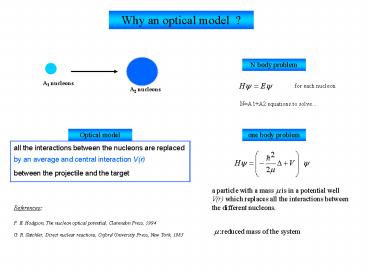for each nucleon - PowerPoint PPT Presentation
1 / 5
Title:
for each nucleon
Description:
a particle with a mass is in a potential well V(r) which replaces all the ... reflexion of the incident wave. imaginary. real part. imaginary part ... – PowerPoint PPT presentation
Number of Views:40
Avg rating:3.0/5.0
Title: for each nucleon
1
Why an optical model ?
N body problem
A1 nucleons
for each nucleon
A2 nucleons
NA1A2 equations to solve....
one body problem
a particle with a mass ? is in a potential well
V(r) which replaces all the interactions between
the different nucleons.
References
P. E. Hodgson, The nucleon optical potential,
Clarendon Press, 1994
? reduced mass of the system
G. R. Satchler, Direct nuclear reactions, Oxford
University Press, New York, 1983
2
Optical potential
The optical model used to describe the
interaction between two nuclei is inspired by
the optical phenomena.
imaginary
V(r) U(r) i W(r)
real part
imaginary part
represents the elastic scattering
to take into account the others reactions which
can occured
reflexion of the incident wave
simulates the loss of flux due to no elastic
collisions
absorption of the incident wave
V(r) U(r) iW(r) Vso(r) Vc(r)
spin-orbite
Coulomb
3
Phenomenogical optical potential
U(r) Uv f(r)
W(r) Ws g(r) Wv f(r)
Woods- Saxon
R potential radius
a potential diffusness
6He(p,p)6He 150 MeV
elastic scattering data parametrization of Uv,
Ws, Wv, av, aWs, aWv, R, Vso
d?/d? (mb/sr)
p-nucleus, n-nucleus interaction parametrization
CH89 from Varner et al.
nucleus-nucleus interaction not general
parametrization
a projectile on a reduced number of target or
limitation in energy.
parameters adjusted case by case
nuclei in their ground sates !!!!
?cm (deg)
4
Microscopic optical potential
rt
rpt
Ot
?p
r
rp
Target
?p
Op
Projectile
effective nucleon-nucleon force
Folding
densities ? microscopic or macroscopic densities
5
Link with ABLA
The decay width ? for evaporation
E Eimf Epartner Q ? - B
Now a real potential is used to describe the
transmission probability of particles
Kildir et al., PRC 51, 1873 (1995)
another possibility to calculate ?capture
optical potentials
(nuclei not in their groundstates)
Aleksandra































